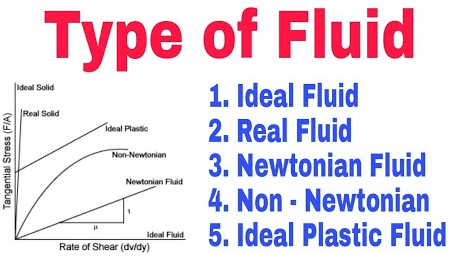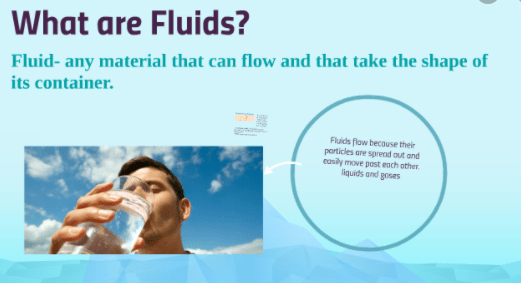Types of Fluids And Their Examples
A fluid is a substance that has no fixed shape and can be flow easily anywhere without facing resistance. it is an important property that is discussed in fluid mechanics. there are five major types of fluids i.e., Ideal Fluid, Real Fluid, Newtonian Fluid, Non-Newtonian Fluid, Ideal Plastic fluid.
In this article, you are going to learn a complete explanation about the Types of fluids.
This post Also includes:
- What is Fluid?
- Types of Fluids
- What is Fluid Flow?
- Equation of Fluid Flow
- Lots more
So if you want to get benefits from this post you’ll love this post.
Let’s Dive right in…!
What is Fluid?
Fluid is a matter composed of weak molecules, has the property of flow, low rigidity, and elasticity with low tendency and capacity to sustain its original shape. it quickly adopts the shape of its container. we can distinguish a fluid easily from solids for his property to change its shape. the fluid can either be liquid or gas depending on the cohesion forces between their molecules. fluid is said to be a type of continuous medium.

What are some examples of fluids?
- water
- volcanic magma
- oil
- air
- tomato sauce
- alcohol
- the noble gases (neon, xenon, krypton, helium, etc.)
- paint
- blood
Types of Fluids
- Ideal fluid
- Real fluid
- Newtonian fluid
- Non-Newtonian fluid
- Ideal plastic fluid
- Incompressible fluid
- Compressible fluid
- Perfect Fluid
- Super Fluids
Ideal fluid
A fluid that cannot be compressed is sad to be an ideal fluid. it also has no shear stress and viscosity that can flow in a circular pattern. we can determine the pressure of the ideal fluid by EOS. from its name, it is clear that ideal fluid is an imaginary fluid that does not exist in reality.
Real fluid
all those fluids that possess viscosity are known as real fluids.
Newtonian fluid
all those fluids that obey newton’s law of viscosity are said to be Newtonian fluids.
Non-Newtonian fluid
all those fluids that do not obey newton’s law of viscosity are said to be Non-Newtonian fluids.
Ideal plastic fluid
when the specific condition is fulfilled in fluids such as shear stress is proportional to the velocity gradient and also shear stress is more than the yield value, fluids will be known as Ideal plastic fluid.
Incompressible fluid
if the density of fluid does not change by applying an external force, fluid will be known as Incompressible fluid.
Compressible fluid
in contrary to Incompressible fluids, if the density of fluid does change by applying an external force, fluid will be known as compressible fluid.
Perfect Fluid
a fluid that is characterized by isotropic pressure p and rest-frame mass density. it is an idealized model where possibilities are neglected completely.
What is Fluid Flow?
the fluid flow is a well-known property of fluids which is a very famous part of fluid mechanics. we discuss the motion of fluid under unbalance forces in fluid flow. the result of this study points that motion will continue until unbalanced forces are applied.
Types of Fluid Flow
- Steady and Unsteady Flow
- Viscous or Non-viscous Flow
- Uniform and Non-Uniform
- Laminar and Turbulent
- Compressible and In-compressible
- Rotational and Ir-rotational
- One, Two, and Three -dimensional Fluid Flow
Steady and Unsteady Flow
- Steady flows are those whose characteristics i.e., velocity, density, pressure cannot be changed with time, and the velocity of the fluid is constant at any point.
- Unsteady flows are those whose characteristics i.e., velocity, density, pressure can be changed with respect to time, and the velocity of the fluid is variable at any two points.
Viscous and Non-viscous Flow
the flow which feels flow resistance is known as viscous flow under the fluid factor of viscosity while the fluids with no or negligible resistance are said to be non-viscous flow.
Uniform and Non-Uniform flow
if the velocity at any given time does not change with respect to time, it is said to be a non-uniform flow while on other condition when velocity at any given time does change with respect to time is known as Uniform flow.
Laminar and Turbulent flow
- laminar fluid flow: the flow in which the particles move in a streamlined path in a straight and parallel way.
- Turbulent flow: the flow in which the particles move in a zig-zag by causing a high energy loss.
Compressible and In-compressible flow
Compressible Fluid Flow: the flow in which the density of the fluid is changed from point to point. in other words, the J ≠ constant (J symbolize density)
Compressible Fluid Flow: the flow in which the density of the fluid does not change from point to point. in other words, J = constant (J symbolize density)
Rotational and Ir-rotational flow
Rotational fluid flow: the type of fluid flow in which particles follow a streamlined path along with rotation about their own axis.
irrotational Fluid flow: the type of fluid flow in which particles follow a streamlined path along but do not rotate about their own axis.
One, Two, and Three -dimensional Fluid Flow
when the velocity is a function of time and one space co-ordinate only, say x is known as one-dimensional flow (u=f(x), v=0, and w=0).
when the velocity is a function of time and two rectangular spaces co-ordinate say x,y. is known as two-dimensional flow (u= f1(x,y,), v= f2(x,y,) and w= 0).
when the velocity is a function of time and three mutually perpendicular directions. The function of 3 space coordinates (u= f1(x,y,z), v= f2(x,y,z) and w= f3(x,y,z)).
Equation of Fluid Flow
Equation of Fluid Flow helps us to determine the Mass flow rate. it is the movement of fluid through a unit area that tells us the movement of fluid mass per unit area.
Mass flow rate=ρAV
from the above equation, it is clear that the Mass flow rate dependable on the density, viscosity, and area of the flowing fluid.
List of Properties of FLuids
the following list falls under the properties of fluids that are responsible to flow. they also decide the behavior and characteristics of the fluid in motion and rest. some of the properties are considered primary while others are secondary types.
- Surface Tension
- Viscosity
- Density
- Specific Weight
- Specific Volume
- Compressibility
- Pressure
- Temperature
- Internal energy
- Enthalpy
- Entropy
- Specific heat
- Cohesion
FAQ’s (Frequently Asked Questions)
What are 3 examples of fluids?
Blood, Mercury, Honey are three common examples of Fluids
What are the different types of fluid flow?
basically, there are seven types of fluid flow which are as follows:
- Steady and Unsteady Flow
- Viscous or Non-viscous Flow
- Uniform and Non-Uniform
- Laminar and Turbulent
- Compressible and In-compressible
- Rotational and Ir-rotational
- One, Two, and Three -dimensional Fluid Flow
How many types of fluids exists?
basically, there are four types of fluids ideal fluid, Real fluid, Newtonian fluid, and non-Newtonian fluid.
What are the 3 types of fluid flow?
- Uniform and Non-Uniform Flow
- Laminar and Turbulent Flow
- Compressible and Incompressible Flow
What are the three types of hydraulic fluids?
petroleum-based, water-based, and synthetics are known the common types of hydraulic fluids.
You May Also Like:

